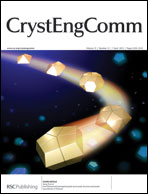A transparent Ti4+ doped hematite photoanode protectively grown by a facile hydrothermal method†
Abstract
Ion doping is a very effective method to improve the photoelectrochemical performance of photoelectrodes. Generally, it is difficult to prepare doped samples by hydrothermal methods. In this study, we prepare Ti4+ doped α-Fe2O3 films by a facile hydrothermal reaction and find that Ti4+ also plays a shielding effect on the Fe2O3 growth process for the first time. The thickness of the pure Fe2O3 film increases initially and then decreases, while the thickness of the Ti4+ doped samples always increases and reaches plateau values when the hydrothermal time is prolonged, which suggests that Ti4+ plays a role in preventing the α-Fe2O3 films from dissolving into the acid aqueous solution during the hydrothermal process. Moreover, the ion doping effect on the doped Fe2O3 is also compared with that of doped samples prepared by other methods in the literatures. The results indicate that the increase of carrier concentrations, rather than morphology change or surface


 Please wait while we load your content...
Please wait while we load your content...